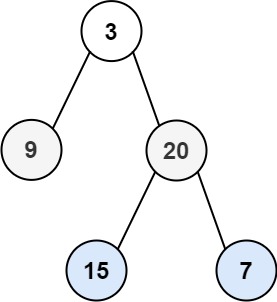Binary Tree Zigzag Level Order Traversal
description
Given the root of a binary tree, return the zigzag level order traversal of its nodes' values. (i.e., from left to right, then right to left for the next level and alternate between).
Example 1:

Input: root = [3,9,20,null,null,15,7] Output: [[3],[20,9],[15,7]]
Example 2:
Input: root = [1] Output: [[1]]
Example 3:
Input: root = [] Output: []
Constraints:
- The number of nodes in the tree is in the range
[0, 2000]. -100 <= Node.val <= 100
submission
// Definition for a binary tree node.
// #[derive(Debug, PartialEq, Eq)]
// pub struct TreeNode {
// pub val: i32,
// pub left: Option<Rc<RefCell<TreeNode>>>,
// pub right: Option<Rc<RefCell<TreeNode>>>,
// }
//
// impl TreeNode {
// #[inline]
// pub fn new(val: i32) -> Self {
// TreeNode {
// val,
// left: None,
// right: None
// }
// }
// }
use std::rc::Rc;
use std::cell::RefCell;
impl Solution {
pub fn zigzag_level_order(root: Option<Rc<RefCell<TreeNode>>>) -> Vec<Vec<i32>> {
// alternating "queues"
let (mut queue, mut swp) = (vec![], vec![]);
let mut ans = vec![];
if let Some(node) = root {
queue.push(node);
}
// outer loop
while !queue.is_empty() {
let mut level = vec![];
// we need to reverse the vec since vec is filo
queue.reverse();
// inner loop
while let Some(node) = queue.pop() {
let node = node.borrow();
level.push(node.val);
if let Some(left) = node.left.clone() {
swp.push(left);
}
if let Some(right) = node.right.clone() {
swp.push(right);
}
}
if ans.len() % 2 == 1 {
level.reverse();
}
std::mem::swap(&mut queue, &mut swp);
ans.push(level);
}
ans
}
}